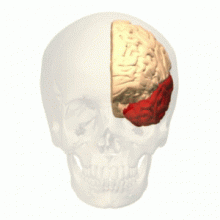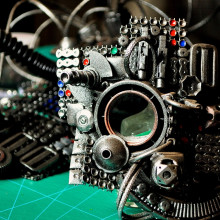Toddlers addicted to smart phones, speaking to a cyborg, computers that predict emotion, electrically inducing human creativity and is technology widening the inequality gap?
In this episode

01:49 - Children addicted to smart phones?
Children addicted to smart phones?
with Dr Richard Graham, Tavistock Clinic, London
Children, as young as four, are receiving treatment for technology addiction.
We are joined by Dr Richard Graham, consultant child and adolescent psychiatrist at the Tavistock Clinic, London who launched the UK's first young person's technology addiction treatment clinic.
Hannah - Today's children seem to be surrounded by technology -  Smartphones, internet connected TVs, baby proof iPad covers and even iPotties. A recent survey of over 1,000 families by babies.co.uk suggests that 1 in 7 parents let their toddlers use such gadgets for 4 hours or more a day. Perhaps it's no surprise then that we're hearing reports of children as young as 4 who are receiving treatments for technology addiction. I spoke with Dr. Richard Graham, Consultant Child and Adolescent Psychiatrist at the Tavistock Clinic London. He's launched the UK's first young person's technology addiction treatment clinic.
Smartphones, internet connected TVs, baby proof iPad covers and even iPotties. A recent survey of over 1,000 families by babies.co.uk suggests that 1 in 7 parents let their toddlers use such gadgets for 4 hours or more a day. Perhaps it's no surprise then that we're hearing reports of children as young as 4 who are receiving treatments for technology addiction. I spoke with Dr. Richard Graham, Consultant Child and Adolescent Psychiatrist at the Tavistock Clinic London. He's launched the UK's first young person's technology addiction treatment clinic.
Richard - In setting up these services, I wanted there to be a place that if someone had a query or a question, there would be a place to turn to because I think within the health space, there's been huge debate as to how serious or not these issues are. But as we see the evolution of technology and their access to devices becomes even easier as it gets smaller and then very soon, they'll be on our heads or on our wrists. That I think there are questions at times about consumption and use or a parent might want to know where to turn. So, that's very difficult for small children to use terms like addiction because most children won't be addicted to a teddy bear or a doll by those criteria and will be distressed if you take it away. But the principle was that, to try and get a healthy adjustment, a healthy balance to using devices and certainly not completely restricting them.
Hannah - According to 2008 report by the European Union, 1 in every 100 children in Europe currently meet the criteria for technology addiction because when deprived, they become chronically agitated and irritable. I asked Richard about treating toddlers addicted to technology.
Richard - Today, I was even from a child psych therapist, just observing how much children absolutely taking notice of a parents' use of devices and are fascinated by the amount of attention we, as adults give to Smartphones and iPads. So, I suppose if thinking about this, you know, one is thinking that we ourselves need to model a healthy adjustment to the devices and be aware that we're being watched by small and older children for that matter in our use of them. But in saying that, I suppose fundamentally, if you feel that the use of any device with playing some other wonderful games and really enjoying that interactive screen, which for a child will help hand, eye coordination develop. And it gives them a sense of being able to change their world in a way that would've been unknown to many of us, which is great. But if that gets in the way of eating, of going to bed, of needing to go out, etc, then there's a very early sign that you need to start to establish some boundaries in relation to that. So, the child has a clear sense of what the expectations are and can then either trying to give them some notice before you're going to be asking them to stop. I mean, they're always at a critical point in the game whenever it's time to stop.

05:41 - Monitoring mouse social interactions
Monitoring mouse social interactions
Published in the journal e Life, Prof. Alon Chen and colleagues at the Weizmann Institute, Israel, present a new method for analysing how groups of mice interact with each other.
This new system has taken five years to develop and may save hours of  scientists time on consuming data analysis. It works by painting the fur of individual mice with different coloured UV paints, illuminating them with a UV lamp and then recording the movements of the nocturnal mice during the night. A computer system then takes the video'd movements, generates 10, 0000 rows of data per hour of recorded footage, and translates this into predictive behaviours such as grooming, sniffing, feeding together, exploring or simply avoiding the other mice!
scientists time on consuming data analysis. It works by painting the fur of individual mice with different coloured UV paints, illuminating them with a UV lamp and then recording the movements of the nocturnal mice during the night. A computer system then takes the video'd movements, generates 10, 0000 rows of data per hour of recorded footage, and translates this into predictive behaviours such as grooming, sniffing, feeding together, exploring or simply avoiding the other mice!
By providing a system for analysing complex social interactions between large groups of mice, this could pave the way to a greater understanding of disorders associated with altered social interaction, such as autism.
Researchers can tweak the genes or environment of mice and then relatively quickly see how it affects their social behaviour. The scientists have firstly applied this technique to find out how the environment affects how mice interact with each other. Their finding? Mice that have been raised in a stimulus-rich environment have less complexity in their social interactions than those growing up in more Spartan conditions. In essence: mice that had grown up in the complex environment were more territorial and worked as pairs rather than as a larger group. The scientists comment that this finding in mice ties in with the common belief for humans that our modern, stimulation-filled environment encourages individualistic behaviour while simpler surroundings give rise to a more developed community life.
The authors plan to continue collecting data from this system, asking questions such as "How do mutations in various genes affect social behaviour? What about the behaviour of mice that overproduce such hormones as oxytocin (the love hormone) or testosterone? Do mice with the behaviour patterns of autism or schizophrenia function better in certain environments? How do groups of mice learn in a group?"

07:38 - Technology: brain hindrance or help?
Technology: brain hindrance or help?
with Baroness Susan Greenfield
Now, Rodents don't spend their time of Facebook, wander around with Twitter open on their mobile phones, and continuously bombard their brains with information with the online world.
So, what have studies in humans shown us about technology and the human brain? I caught up with Baroness Susan Greenfield....
Susan - Certainly, it can be having an effect on attention span. Certainly, we know that there's an important chemical called Dopamine that's released in the brain during gaming and that's related to arousal and addiction, and reward. There's also evidence suggesting that that too would be released during social networking. In social networking, it's neither stressful nor relaxing, but it is very pleasurable. But social networking, there's also issues of empathy and sense of identity, evidence that perhaps with social networking where you're relying on that as your main vehicle for relationships. There's evidence of narcissism and low esteem, but I don't want to do simple sound bites because that doesn't do justice to the work because it's only really been going for the last few years. If you think about it, Facebook has only been around since 2007 or so. So, it's not as if there are cut and drive definite proof that X or Y is the case.
Hannah - I think that was the major point there, that the technology is moving so fast and the social structure is changing at such a high rate.
Susan - Exactly. To do a proper study takes 6 months or so. First, you need to get the funding. You need to apply for a grant to get the funding and so on. So, the science is sort of always lagging behind and I think people have rather strange expectations of what the science can show.
I often say to my detractors, "Well, you told me a single experiment, the single smoking gun experiment that will prove conclusively either way this is all good or bad." And that of course is not going to happen because it's obviously neither all good or bad and you have to frame a specific question you're going to test in a specific situation for a specific thing. So, I think people that expect of science or scientists, simple proof one way or the other need to really recalibrate their expectations of what science can deliver.
Hannah - Thanks to Susan Greenfield.

10:05 - Electrical Stimulation to Think Outside of the Box
Electrical Stimulation to Think Outside of the Box
with Allan Snyder, University of Sydney
Chris - Scientists have discovered how to create a thinking cap. I love this! It helps people to become much more creative. The work is based on observations that sometimes damage to the front part of the brain's left temporal lobe can disclose extraordinary artistic and musical talents that a patient never knew they had.
Now, Richard Chi and Allan Snyder from the Centre for the Mind at the University of Sydney have used a non-invasive technique called transcranial direct current stimulation to harmlessly reduce the activity in this front part of the brain which boosted the problem solving abilities of a large group of healthy volunteers. Allan Snyder...
Allan - Well, the big picture is inspired by the quote from William Blake, "If the doors of perception were cleansed everything would appear to man as it is, infinite." So we were confronting the challenging problem of how to artificially induce a less-filtered view of world, one less constrained by preconceptions.
Chris - In other words, the world that we see is one tinted by past experience. You learn something and that informs the way that you interpret the world henceforth.
Allan - Precisely. Our perceptions, our memory, our decisions are based  on filtered information. We view the world, in a sense, "top down" through concepts, through mental templates, which are built up from our past experience. Of course, these concepts are crucially important for our survival. They enable us to make rapid predictions about what is most likely, based on only partial information. But the strategy leaves us susceptible to certain kinds of perceptual and cognitive errors. Visual illusions, false memories, prejudice, and it makes us inclined to connect the dots in ways that are familiar rather than to explore novel interpretations.
on filtered information. We view the world, in a sense, "top down" through concepts, through mental templates, which are built up from our past experience. Of course, these concepts are crucially important for our survival. They enable us to make rapid predictions about what is most likely, based on only partial information. But the strategy leaves us susceptible to certain kinds of perceptual and cognitive errors. Visual illusions, false memories, prejudice, and it makes us inclined to connect the dots in ways that are familiar rather than to explore novel interpretations.
Chris - Which makes it much harder to think outside the box if you're trying to solve a problem and you're trying to solve a hard problem that other people have grappled with. There's probably going to be an original solution. Going down the same wrong road they have is the wrong approach. You need to think in a new way and if we can find a way to do that, we'd be better off.
Allan - Yeah. I mean, it's not the wrong approach. It's the good approach, but it's not going to work if it doesn't apply. In other words, our observations of the world and the problems we are talking about are strongly shaped by our preconceptions from previous problems where that didn't work.
Chris - So how have you tried to get an angle on what the brain is doing and how to get around that problem then?
Allan - What if we could temporarily inhibit this top down processing and thereby access a level of perception normally hidden from conscious awareness? Might we be able to have a world which is less preconceived? Of course, we'd only want to do this temporarily. We need our conceptual make-up, we don't want to be like an infant, but that's the kind of rationale that's behind our work.
Chris - So how did you actually tackle this problem? What did you do?
Allan - We used safe, non-invasive, transcranial direct current stimulation to inhibit the left anterior temporal lobe - that's an area associated with conceptual processing, labels and categories. In addition, we simultaneously excited the right anterior temporal lobe - an area associated with insight and novel meaning. The objective was to temporarily induce a less filtered, less assumption-driven cognitive style.
Chris - And what did you ask people to whom you were doing this to do, in order to see if they were thinking in a new way or thinking more originally?
Allan - Well we took a standard problem of insight, a match stick arithmetic visual problem, and we showed them how to do one class of those problems and then asked them to do a much harder problem that required a novel turn, a novel twist, and the people who received direct current stimulation, three times as many as them solved the problem than those in the control group.
Chris - The argument would be that because you had to think about the problem in a novel way, this suppression of the left side of the brain which normally forces you to think in this hypothesis-led familiar or way informed by familiarity, that having been turned off, they began to think in a novel way and that's what gave them this insight to solve the problem in a new way.
Allan - Yeah. That's the way we look at it.
Chris - So now you've found this, what's the next step? Is it to say right, "can we try and apply this to other modalities?" So that's a problem-solving task, it's part visual, part cognition. Are you now going to start looking at other things that might be informed by the same strategy?
Allan - You're right. Every sensory modality uses the top down process. So, we indeed have been trying to think about other experiments we could do that would illustrate this concept, and we have a few in mind.
Chris - Maybe you need to stimulate your brain to suppress it to attune the left antero-temporal lobe to see what comes out. But practically speaking, could you use this for anything? Do you think musicians should plug themselves in? Should mathematicians grappling with tough problems plug themselves in like this, to see if they can free their mind?
Allan - Richard Chi and I suggested that it might be a "thinking cap". The concept about a thinking cap, I think many people regard a thinking cap as something that might be a Google retriever, but we don't need that because we have Google. What we really need in the future is a way to connect seemingly disparate pieces of information into a new synthesis. In other words, to look at things afresh and that is what I would hope a thinking cap could give us - a creativity enhancer in that sense and yes, this is something that could be used in the future. It's a very simple device. It uses a 9-volt battery. What we need to do is try to optimise the configuration of stimulation on the brain, we need to think about the time interval that we want to expose people to, there are many variables here to optimise this, once you accept the reality or the proof of principle.
Chris - I think I could use one of those thinking caps. That was Professor Allan Snyder who is the Director of the Centre for the Mind at the University of Sydney, and he published that work in the journal PLoS One.

16:16 - What's it like to live as a cyborg?
What's it like to live as a cyborg?
with Kevin Warwick, Reading University
Kevin Warwick, Cybernetics Professor at Reading University has delvedg deep into his nervous system to become one of the world's first cyborgs. We find out more.....
Kevin - Well, I've had a number of implants. The most successful one from it consisted of 100 electrodes, very small spikes which were fired into the nervous system in my left arm to link my nervous system with a computer and then on to the internet. So essentially, we're using neural signals that are signalled from my brain to control the robot hand in various places of technology. But also, to feed signals back from a computer into my nervous system, so I could so I could experience the extrasensory input, learn to recognise ultrasonic signals for example and recognise distance to objects, and so on. It was really looking at extending the abilities of a human by using implant technologies, implant technologies of that kind.
Hannah - What were your own reasons for wanting to become one of the world's first cyborgs?
Kevin - Well, it was two-fold. One was to look at the technology and assess  it for looking at helping people who have problems for therapeutic purpose - people who are paralysed or people who are blind. All sorts of different cases where the person's brain is functioning perfectly okay, but there is a problem getting signals from the brain to the outside world for them to move or operate technology, or whatever happens to be, or getting signals into the brain. It was really in a general way, how could people like that be helped. But at the same time, the second aspect was just, "Okay, well if we're linking directly to the brain then we're no longer restricted by the physical input/output that humans have - the human body such as the eyes and ears, or hands and legs to move. If you connect directly to the brain then you can connect with all sorts of other pieces of technology and so, the person can have lots of different extra abilities - different senses and control different things from their brain directly. So, it was looking at the enhancement side, allowing people to have extra abilities, as well as just using the same technology for therapeutic purposes.
it for looking at helping people who have problems for therapeutic purpose - people who are paralysed or people who are blind. All sorts of different cases where the person's brain is functioning perfectly okay, but there is a problem getting signals from the brain to the outside world for them to move or operate technology, or whatever happens to be, or getting signals into the brain. It was really in a general way, how could people like that be helped. But at the same time, the second aspect was just, "Okay, well if we're linking directly to the brain then we're no longer restricted by the physical input/output that humans have - the human body such as the eyes and ears, or hands and legs to move. If you connect directly to the brain then you can connect with all sorts of other pieces of technology and so, the person can have lots of different extra abilities - different senses and control different things from their brain directly. So, it was looking at the enhancement side, allowing people to have extra abilities, as well as just using the same technology for therapeutic purposes.
Hannah - What kind of implications for society do you think that this technology has?
Kevin - First point is, I think we can and we'll see over the next 10 years, all sorts of different neurological problems that will be tackled by using technology of this type. So, things that at the moment, we couldn't imagine and then maybe chemicals, pharmaceuticals are the best we got. So, things like Schizophrenia for example, I think that it's going to be tackled by using this technology. Deep brain stimulation is available now to successfully tackle Parkinson's disease for example and it's also being used for things like Turret Syndrome, epilepsy. So, these are electrodes deep in the brain that can counteract the effects of a particular problem. Schizophrenia is amongst the problems - it's a much broader problem, but it's one of the problems that are now being looked at and initial investigations are being made as to where exactly to apply electrical currents to overcome the problems where to stimulate. I think partly, it's opening up more of an understanding on the problem, but also, with the possibility of actually tackling the problem itself.
Hannah - What do you think was the - from your experiment on yourself - had the most impact on your life in terms of the kind of extra skill that you gave yourself?
Kevin - The biggest thing for me, my wife also had electrodes implanted and we'd send signals from brain to brain, literally communicating electronically directly. I think in the future, that's going to be the biggest thing of using technology into the brain that we will be able to send signals to communicate directly from brain to brain, between humans, humans and machines, and so on. Therefore, this form of communication we call speech which is pretty pathetic technically, will be obsolete before long. We'll communicate just by thinking to each other.
Hannah - What did you communicate with each other?
Kevin - For us, it was a very, very basic thing. A bit like, if you can remember the Morse code and telegraph type signalling dots and dashes. When my wife closed her hand, my brain received an electronic pulse. So, she throws down 3 or 4 times, "dic, dic, dic, dic" like that, my brain receives several pulses. So, it was very much the first basic type of communication. But when we have a much broader connection directly from brain to brain then clearly, it will open up all sorts of communicating in terms of thoughts, images, feelings, emotions a much broader range of communication than we have at present.
Hannah - Thanks to you, Kevin Warwick who started cyborg communications with his wife back in 2002.

22:00 - Could computers crack human emotions?
Could computers crack human emotions?
with Prof Peter Robinson, Cambridge University
Could computers ever have the power to predict our emotions and change them? To find out I caught up with Professor Peter Robinson, Computer scientist at Cambridge University.
Peter - It's a crucial part of human communications. It's being studied scientifically since Darwin's time. He was interested in the way that we use facial expressions to convey these signals. People who can't do it are at a social disadvantage. It's people with autism spectrum conditions. So, in that sense, computers are autistic. They don't recognise these signals. So, the computer carries on blithely saying whatever it wants to say or doing whatever it wants to do, and it doesn't look at the expression on your face, or the tone of your voice as you interact with it. And so, we've been looking at ways that we can give computers some sort of emotional awareness.
Hannah - Building clever algorithms that can actually read emotion? That's  quite a feat! It must be very complicated maths that you're plugging in there and it must have been a huge amount of emotion reading that you must have had to sift through in order to build the algorithm in the first place?
quite a feat! It must be very complicated maths that you're plugging in there and it must have been a huge amount of emotion reading that you must have had to sift through in order to build the algorithm in the first place?
Peter - That's right. Well, right on both those accounts, we've worked with our friends in the Autism Research Centre, Simon Baron-Cohen and he's interested in the real people who have autism spectrum conditions. And so, we've joined a lot on his research work into the theory of emotions. On top of that, we've used all the usual sorts of things that computer scientists use nowadays. Essentially, this comes down to machine learning rather than actually writing a programme that tabulates exactly how to interpret these social signals that people are giving out. We write systems that learn from examples. We've had lots of video clips and audio clips of actors expressing emotions. We can use those to train our systems. In this context, we know the probability that you'll particular facial expressions. If you're feeling a particular emotion, we can calculate those and this allows us to turn it the other way around, so that when we see the facial expressions, we can work out the probability of different mental states. One of the projects is looking at ways in which we can make computer games that might be able to help children say, with Asperger syndrome who are often very intelligent; they just lack the ability to read these emotions. They know they have a problem. They want to do something about it. We can make computer games that help them learn to read these expressions in other people.
Hannah - And so, how sensitive or how accurate is this computer at reading and gauging people's emotions?
Peter - Also, an interesting question. The sensitivity is fairly good. Different people have different magnitude with which they express emotion. Different cultures are more expressive or not. But the accuracy, well, it's not like the sort of computer system that you're used to - your spreadsheet. This does not give you a precise, accurate, precise answer. Emotions are things that different people perceive differently. There's a consensus view. But even when we show our video clips to a human audience, we're unlikely to get them all agreeing exactly on what they're seeing. So, if we give them say, 6 choicesx we get maybe a 70% agreement rate. But that turns up to be about the same sort of agreement accuracy that you'd get if you were showing it to people rather than the computer. So, it's quite important when you're using this sort of information from a computer system - the sensors that are reading these social signals to understand that they're a hint rather than an absolute description. That means that the way that the computers react to this information has got to be rather different and we haven't really had much time to even think about how we use this information, how we change the way the computer is operating in response to the emotions that it's detecting and its uses. We did some trials particularly just in the problem of car drivers, dealing with busy roads, unfamiliar environments and increasing amounts of technology in the car. We wanted to see if we could detect when a car driver was upset by the environment and perhaps adapt accordingly. We set up some simulations for this.
The thing that we observed first of all is that actually, most of the time in our driving simulator, people are just completely neutral. They don't have to show any emotions and is rather deceiving. So, there's then an even more difficult question of what to do in response to the information. So again, to take the example of a car driver, if you see a car driver who is getting aroused and frustrated, and angry, actually, it's rather a bad idea to have a computer system that patronise and he tells him to calm down actually. The computer has to mirror the emotion of the person that it's interacting with, but lower intensity - firm but not offensive.
Hannah - Thanks to you Peter Robinson from Cambridge University.

Will technology increase social divide?
We close the show with Tamara Roukaerts, marketing tech expert from TRM&C who answers a question that listener Peter Macree got in touch with: Could rapid advancements with technology lead to higher levels of social inequality? Tamara - Well certainly, a lot of technology does confer an efficiency advantage on people who use it. So, if you have a Smartphone, there potentially is an advantage over someone who has a feature phone. If you use the internet, you potentially have an economic advantage over somebody who does not use the internet. These kinds of disparities in access to technology do have socio-economic implications. They can sometimes even serve to increase the divide. I think that's why it's so important to bear that in mind when new technologies come on stream, so that fewer people get left behind. It's really easy to glance over the fact that over 20% of the UK population have yet to go online. That's more than 10 million people and 16 million lack basic internet skills, like being able to send an email or browsing the internet. Potentially, that would be like a social or an economic handicap. You might find it extremely difficult to get a job. Over 90% of jobs these days actually have some ICT component to them.
Hannah - Thanks to Tamara Roukaerts.
- Previous Why does the Universe Spin?
- Next MS Costa Concordia










Comments
Add a comment